Biden built back Pennsylvania's own 'blue wall' — one brick at a time
Former Vice President Joe Biden rebuilt the Pennsylvania section of the “blue wall” one brick at a time as he amassed a lead that led The Associated Press to declare him president-elect Saturday.
Preliminary returns show how he held onto Philadelphia, flipped back Erie and Northampton counties and built larger margins than those Hillary Clinton won in Allegheny and four suburban Philadelphia counties in 2016. Along the way, he expanded significantly on Clinton’s victory in Lackawanna County.
And then there were the grassroots groups laboring in rural counties across the state that vowed simply to hold down President Trump’s margins in Pennsylvania’s pulsing red center even as momentum built toward a record turnout in Tuesday’s election.
“People want to believe there was this gigantic single factor, but it’s the opposite. It is lots of small marginal shifts that, in all likelihood, gave (Biden) a victory in Pennsylvania,” said Chris Borick, a political scientist and pollster at Muhlenberg College.
Indeed, as the final count of mail-in ballots trickled in Saturday, it appeared Biden will beat Trump in the Keystone State by something in the neighborhood of the 44,000-vote victory Trump pulled off against Clinton in 2016. Four years ago, Pennsylvania, Michigan and Wisconsin — the Democrats’ so-called blue wall states — went for Trump by a total of 77,000 votes.
Both Michigan and Wisconsin were called for Biden early on, while the former vice president’s quest for 270 Electoral College votes hinged on the slow vote count in Pennsylvania, where election officials plowed away at counting 2.5 million mail-in ballots.
That the Keystone State and its 20 Electoral College votes was viewed as a must-win for both campaigns was apparent in five dozen visits the candidates and their surrogates made to the state over the last 18 months. Campaign spending here approached $100 million between the candidates and political action committees.
Biden, who was often referred to as Pennsylvania’s third senator during his decades representing Delaware, underscored the state’s importance when he announced his candidacy for the Democratic nomination in his first public campaign outing in Philadelphia in late April 2019. His first campaign stop was in Pittsburgh, at Teamsters Union Local 249 hall in Lawrenceville. “I came here because, quite frankly folks, if I’m going to be able to beat Donald Trump in 2020, it’s going to happen here,” Biden said at the April 29, 2019, event. “With your help, I think we’re going to be able to do that.”
Borick said he began to see a path for Biden in Pennsylvania when Northampton County became one of the first counties in the state to finish its vote count. It showed that Biden beat Trump there 83,163 to 82,416.
“Northampton is one of the best bellwether counties in the state,” Borick said. “It has missed going for the winner in presidential races, maybe, once in the last 100 years.”
To the north in Lackawanna County, where Clinton beat Trump by 3,500 votes in 2016, Biden built his edge to 9,623 votes in the county surrounding his grandparents’ beloved Scranton homestead.
Perhaps more significant in terms of raw numbers were the margins Biden amassed in Allegheny County and Bucks, Chester, Delaware and Montgomery counties, the four so-called collar counties surrounding Philadelphia.
In Allegheny, where Clinton pulled down about 368,000 votes to Trump’s 259,000 in 2016, Biden won about 410,000 to Trump’s 272,000. The former vice president performed similar lifts in the four suburban Philadelphia counties.
Political observers credited much of that increase to suburban women, whom even Trump conceded were his Achilles tendon in this race.
Few realized how organized those women were this year.
Stasia Vernallis, a retired lawyer from O’Hara in Pittsburgh’s northern suburbs, was among those at the center of that effort with Progress PA, which became a clearinghouse for the groups.
She said small Facebook groups that grew out of the 2017 Women’s March cropped across the state, learned the ins and outs of grassroots organizing and networked on behalf of the Biden campaign. In many communities, they operated largely beneath the radar of the organized Democratic Party apparatus, raising funds, knocking on doors, running phone banks, underwriting billboards and ensuring there were Biden yard signs everywhere to let supporters know they were not alone.
While the Trump campaign brought out rural voters never seen before this election and the women’s groups helped boost the turnout for Biden in the suburbs, Vernallis said they were part of another important narrative.
In rural counties from Westmoreland, Fayette and Somerset in Western Pennsylvania to Carbon and Monroe counties in the east, the grassroots groups served as a counterweight to Trump’s get-out-the-vote effort in the countryside. It pared back what otherwise might have been sufficient margins to get Trump over the top in the state.
“They were not in it to win, but our goal was to activate as many Democrats as possible and let them know they were not alone and that their votes mattered,” Vernallis said.
Biden is poised to join James Buchanan as the second president of the United States from Pennsylvania. Buchanan served from 1857-1861.
Deb Erdley is a Tribune-Review staff writer. You can contact Deb at derdley@triblive.com.
Remove the ads from your TribLIVE reading experience but still support the journalists who create the content with TribLIVE Ad-Free.

